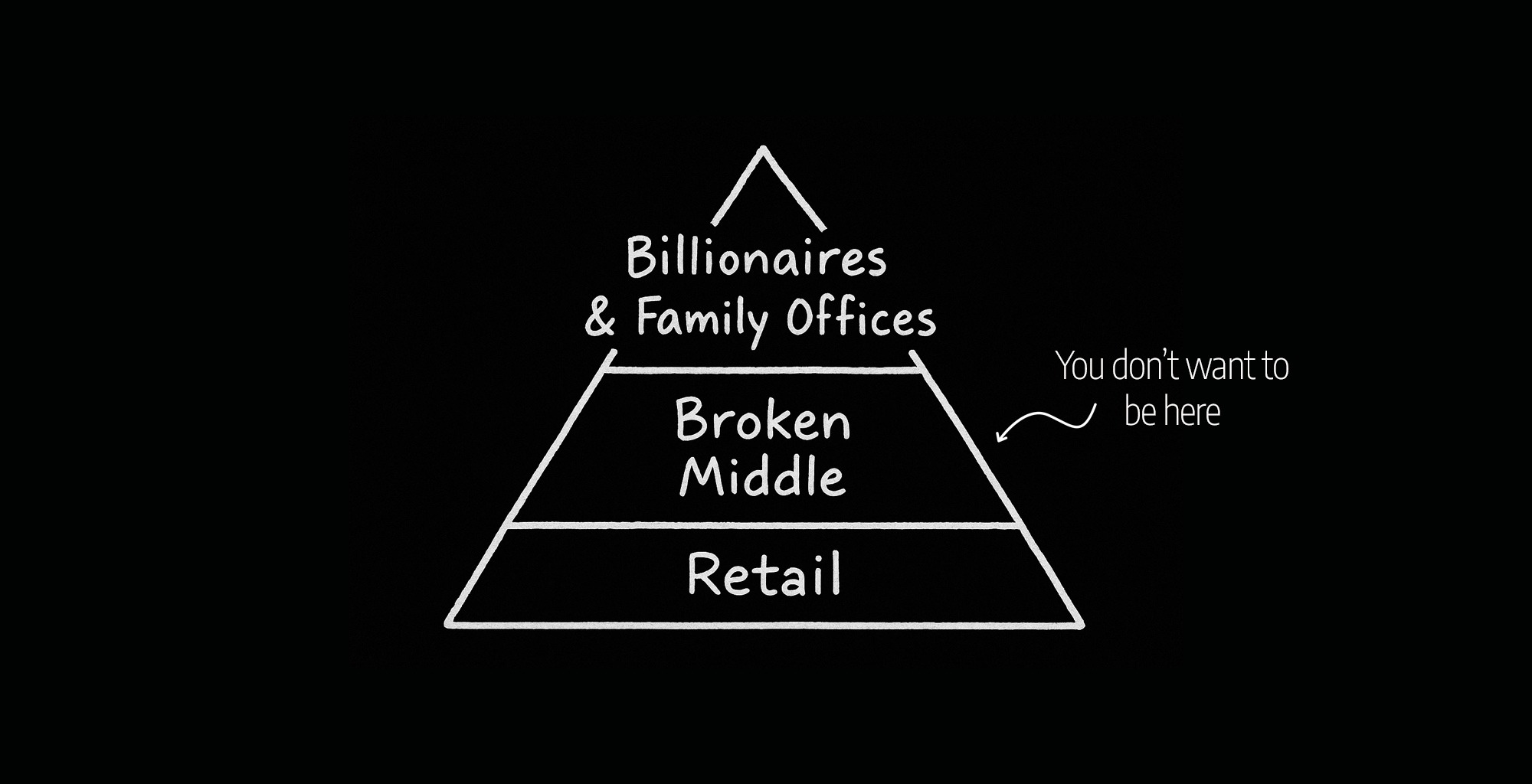WHITE PAPER
The Complexities of The Wealth Hierarchy

Understanding the strategic divide across the wealth pyramid
Today, I want to share with you a framework I’ve developed over years of working with clients, something I call the Wealth Hierarchy. It’s a model I created to explain how wealth management truly operates beneath the surface. Not just by how much you have, but by what kind of game you’re allowed to play.
Wealth is often portrayed as a spectrum from poor to rich, with smoother transitions in between. But in reality, wealth functions more like a pyramid: layered, rigid and deeply segmented.
At the base, you have the retail majority, managing their money through robo-advisors and index funds.
At the peak, the billionaire elite command global investment platforms, family offices and sovereign-style tax strategies.
In the middle sits the high and ultra-high-net-worth tier, arguably the most misunderstood, underserved and overcharged class in the financial world.
This is the paradox of the pyramid: The system works well for the bottom and brilliantly for the top, but it fails the middle.
Let’s take a look at each layer.

Tier 1: The Base – Retail investors and mass affluent
This is where the majority of the population resides. And while it’s the least wealthy tier, it’s also the most efficiently served.
Investment strategy
- Low-cost index funds, ETFs and target-date funds
- Automated portfolios via robo-advisors (e.g., Betterment, Wealthfront)
- 60/40 equity/bond allocations as the default
Costs
- Minimal: Fees range from 0.10%–0.50%
- No hidden layers, no product markups
Results
- Market-mirroring returns
- Transparent, predictable and efficient compounding over time
Tax Strategy
- Robust tax shelters available:
- ISAs (UK), 401(k)/Roth IRA (US), etc.
- Capital gains tax thresholds often not reached
- Low income = eligibility for tax credits, brackets and deferments
The base benefits from scale, automation and government-designed tax relief schemes to encourage long-term investing. No bells. No whistles. But a clear path to slow, steady wealth accumulation.
Tier 2: The Middle – U/HNWIs
This is where the real dysfunction begins.
These are the professionals, entrepreneurs and second-generation inheritors who’ve built meaningful wealth, but are neither retail nor elite.
Investment strategy
- Offered “exclusive access” to private funds and feeder structures
- Advised to diversify into hedge funds, private credit, PE secondaries
- Allocations often resemble glorified retail portfolios with fancy wrappers
Costs
- Fees balloon quickly:
- 1% advisory fee
- fees from underlying funds (2/20 in PE, 1.5/15 in hedge funds)
- custody, platform and administrative charges
- 1% advisory fee
- Many portfolios carry double or triple fee layers
Results
- Underwhelming net returns due to fee drag and product complexity
- Performance dispersion is high, depending on advisor quality
- Conflicts of interest remain rife in product-pushing institutions
Tax strategy
- This group is squeezed hardest:
- Exceed exemption thresholds
- No access to elite international structures
- Exposed to high income tax, capital gains, estate taxes
- No portable residency, citizenship structuring, or advanced estate planning
- Rarely optimised across generations
The middle tier is overexposed, overcharged and under-empowered. It carries the tax burden of the rich, but lacks the tools of the ultra-rich. It pays wealth management fees, but gets retail-level advice.
This is where the wealth system quietly extracts the most value. Let’s be honest, you don’t want to end up here.
Tier 3: The Apex – Billionaires & family offices
This is not “private banking.” This is private infrastructure. At this level, wealth management transforms into wealth architecture.
Investment strategy
- Co-investments, direct equity stakes, venture building
- Ability to dictate terms, structure deals and shape exits
- Influence over where capital flows, from philanthropy to frontier tech
Costs
- Costs are variable and negotiated:
- In-house analysts, legal teams, CIOs
- Fees paid directly to talent, not intermediaries
- Favorable institutional share classes and custom terms
Results
- Asymmetric upside through custom strategies
- Wealth used not only for growth, but for leverage, narrative and legacy
- Return is measured in control and impact, not just performance
Tax strategy
- Elite tax engineers:
- Multi-jurisdictional structuring
- Trusts, foundations, offshore domiciles
- Multi-citizenship strategies, residency arbitrage
- True global mobility for both people and capital
- Often pay a lower effective tax rate than those in Tier 2
This is capital as strategy, not product. Money becomes a tool of vision. While others buy into systems, billionaires build their own, complete with private deal flow, hand-picked teams and tax sovereignty.
Why is the pyramid designed this way
This isn’t accidental. The system works best when the top gets ultimate freedom, the bottom gets scale solutions and the middle pays for both.
- Private banks earn the most by locking up Tier 2 capital
- Governments collect the most taxes from Tier 2 earners
- Tier 2 clients often lack access to neutral, independent advisors
- Tier 2 is large enough to be valuable, but not powerful enough to resist
A structural imbalance hiding in plain sight
We often hear that “the rich get richer.” But that’s incomplete.
- The ultra-rich get richer through control
- The retail class grows predictably through efficiency
- But the wealthy middle bleeds through opacity
Tier 2 is being asked to pay like the rich but operate like the poor, with neither the scale advantages of the base nor the strategic autonomy of the apex.
What tier are you really in?
It’s not just about your net worth. It’s about your:
- Level of control
- Quality of access
- Clarity of costs
- Tax optimisation
- Strategic autonomy
You can have $30 million and still be playing the wrong game.
My advice: Don’t climb the pyramid, escape it
The goal isn’t just to rise in net worth. It’s to graduate from a system designed to extract. Here’s how to start:
- Build your own family office, lean, modular and independent
- Stop buying packaged products, curate or co-create deals
- Hire fee-only, conflict-free advisors
- Revisit your entire tax architecture with multi-generational planning
- Think of your wealth not as capital to protect, but leverage to design
You don’t need to be a billionaire to act like one. You just need to stop thinking like a client and start operating like an owner.
If you’re ready to upgrade your wealth operating system, get in touch. We help entrepreneurial families with the knowledge, tools and resources to future proof their family office.
Reach out to us to start a confidential consultation.
Email hello@fundfront.com or complete the contact form on our website.
Articles that you may also be interested in:
- Selecting the Right Structure for Your Family Office
- How Family Office Software is Transforming Modern Wealth Management
- Comprehensive Software Solutions for Family Offices
- The Family Office 2.0 Manifesto
Disclaimer
FundFront provides operational and technological solutions for fund structuring, securitisation and management. We do not provide legal, tax or financial advice. We recommend that you consult with professional legal or financial advisors to ensure compliance and appropriateness for your specific situation.
Written by:


